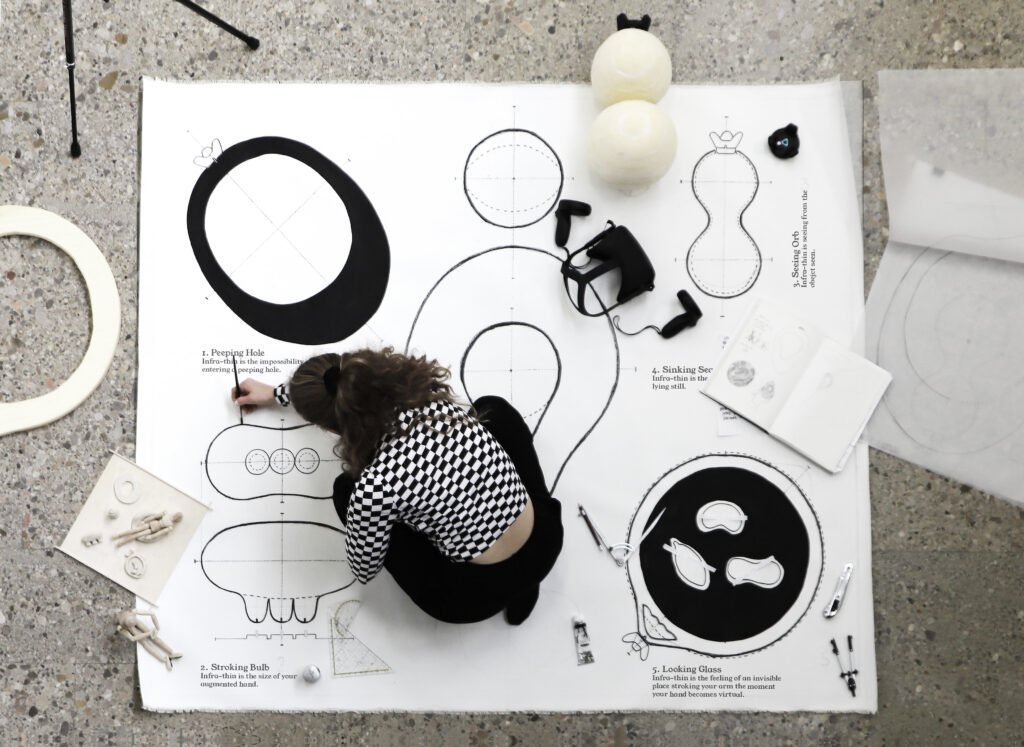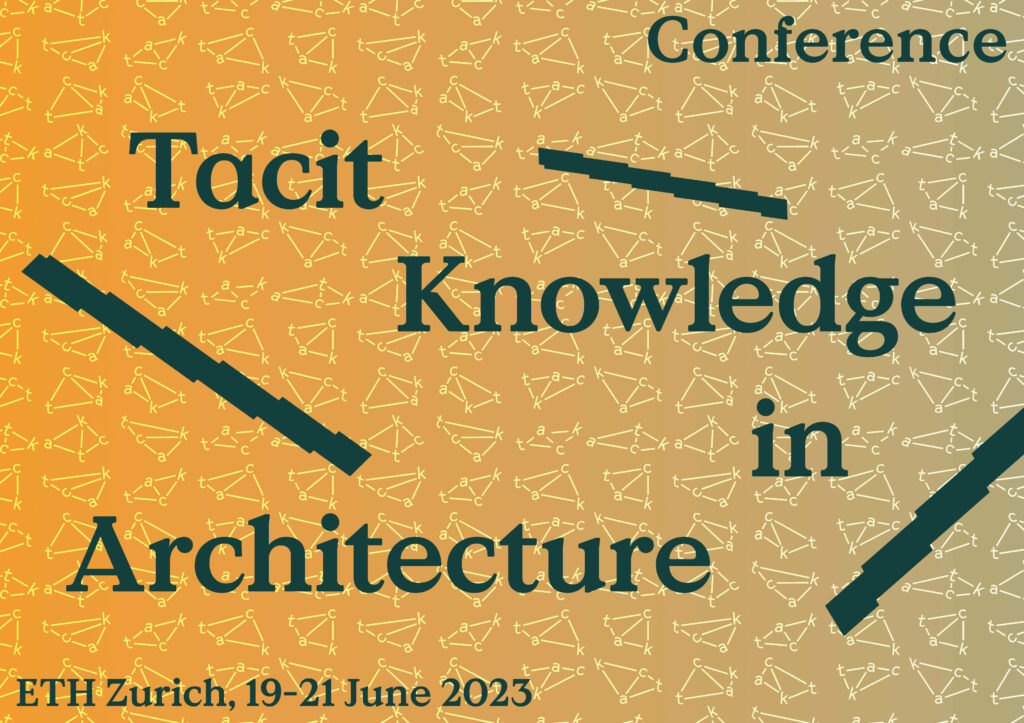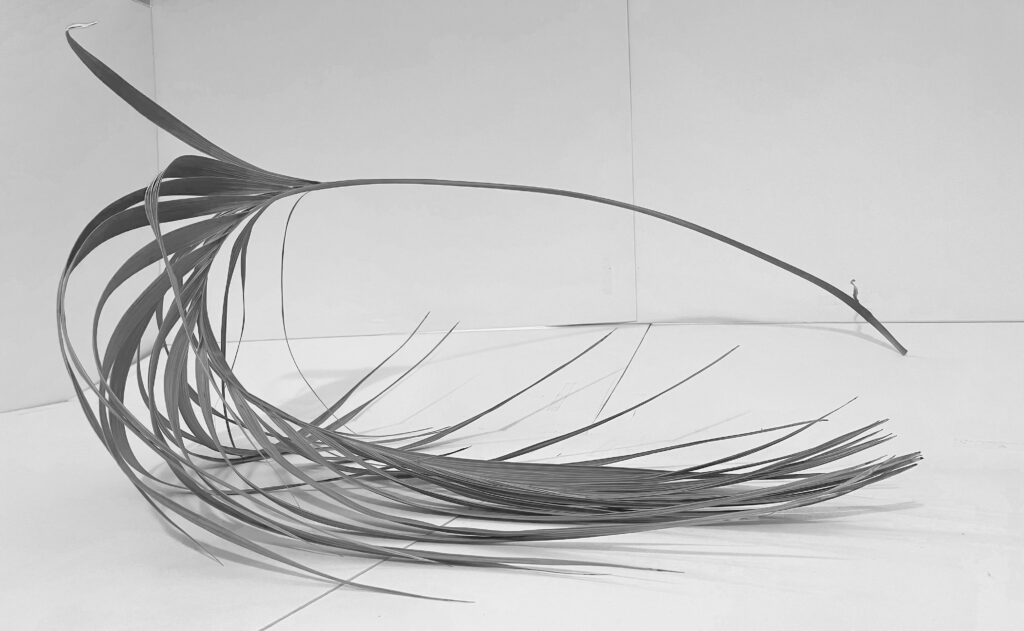Return to archive
title
Exploring The Infra-thin
author
Paula Strunden

Frame from Infrathin Magick by Paula Strunden
Design-led XR research within the PhD framework TACK Communities of Tacit Knowledge: Architecture and its ways of knowing
After his death, Marcel Duchamp left an envelope with 46 loose hand-written notes explaining what he referred to as „inframince“ – the infra-thin. During his lifetime, Duchamp mentioned the term only twice. He said that the notion escaped any scientific definition and was impossible to explain, but he could give examples 1 Duchamp’s notes were posthumously published in French by Duchamp, M., Hultén, K. G. P., & Matisse, P. (1980). Marcel Duchamp Notes. The following simplified translations are based on the notes 4,33,35 taken from p.21 and 33. :
Note 4 – Infra-thin is the warmth of a seat that has just been left.
Note 33 – Infra-thin is when the tobacco smoke also smells of the mouth, which exhales it.
Note 35 – Infra-thin is the difference that exists between two forms that have been cast from the same mould.
Very generally speaking, infra-thin describes a separation, a distance, a gap or delay between two things. According to the art historian Hector Obalk, it could be either a “difference that you easily imagine, but that does not exist, like the thickness of a shadow”, or “a distance (…) that you can not perceive, but only imagine” 2 Obalk, H. (2000). The unfindable readymade. Tout-Fait The Marcel Duchamp Studies Online Journal, 1(2), p.8. .
Paula Strunden’s design-led analysis of the infra-thin notes through the practice of 1:1 drawing, performative re-enacting and real-time three-dimensional simulation lead her to explore the “immeasurable gap” 3 “The margin [infrathin] measures is the immeasurable gap between two things as they transition or pass into one another.” Tucker, T. D. (2008). Derridada: Duchamp as readymade deconstruction. Lexington Books, p. 66. between our perception and imagination. By constructing a family of five mixed reality artefacts that exist simultaneously in the physical and virtual realm, that can be touched, moved, smelled and listened to, Strunden engages her body in a series of ongoing experiments that question to which extent the three-dimensional phenomenal space is merely a construction of our brain.
Through multisensory interactions, the sentient objects Peeping Hole, Stroking Bulb, Seeing Orb, Sinking Seat and Looking Glass, become devices to grasp, reveal and unveil infra-thin space. Instead of experiencing the physical within the virtual, these objects allow us to experience the virtual physically – with and through our body. By rejecting the binary division between the actual and virtual world, between reality and imagination, Strunden’s embodied explorations aim to cross and merge the experience of the two and probe the fleeting sensation of being present at once in more than one
realm.
Strunden gives an example of how to interact with object No. 3 ‘Seeing Orb’: “This one allows you to see from the perspective of the object seen. Upon crouching, pressing your heels into the ground and moving your weight forward to grab and lift the ceramic orb, your virtual vision shifts in between your hands. Now, you can turn your sight by moving the object from left to right. You can tilt it, and you will experience how space pivots around you.”
While our vestibular organs remain steady and our body equilibrium – exposed to forces of gravity and acceleration – has not shifted, our brain believes our environment to be turning instead of its eyes. While our eyes have evolved as part of a complex perceptual system 4 The multisensory nature of human’s visual perception has been analysed by the experimental psychologist James J. Gibson in his seminal books ‘The Perception of the Visual World (1950), The Senses Considered as Perceptual Systems (1966) and The Ecological Approach to Visual Perception (1979). , so has our understanding of the world surrounding us by using them.
Strunden continues to explain her intentions behind object No. 4 ‘Stroking Bulb’: “As my brain never experienced any space independent of my body, the act of scaling down, for example, my hands or increasing the length of my arms in virtual reality, completely changed my perceived dimensions of the environment I was immersed in, not only visually, but it actually made me move faster and quickened my perception of time. Since I have experienced measuring as a form of ruling, controlling or balancing, I started to understand on an intuitive level that the finely tuned multi-sensory interplay of our perceptual apparatus constantly stabilises the world around us.”
5
Strunden, P. (2021). International Lecture Series 2020-21: Female Imagination and the Production of Space. Retrieved from https://vimeo.com/521865810.
What if we could measure the experience of the ‘unstable’ world, the world, independent of our perceptual system? And finally, could Virtual Reality, as a tool to embody other first-person perspectives, not only other bodies but other things, help us reveal different desires and develop a more empathetic approach to architectural design thinking?
These questions will be discussed, among other things, within the framework of the annual foundational TACK meeting at the Bergische University Wuppertal in June 2021, where Strunden is planning to install and put to the test her object-oriented XR experience ‘Exploring the Infra-thin’.
- Duchamp’s notes were posthumously published in French by Duchamp, M., Hultén, K. G. P., & Matisse, P. (1980). Marcel Duchamp Notes. The following simplified translations are based on the notes 4,33,35 taken from p.21 and 33.
- Obalk, H. (2000). The unfindable readymade. Tout-Fait The Marcel Duchamp Studies Online Journal, 1(2), p.8.
- “The margin [infrathin] measures is the immeasurable gap between two things as they transition or pass into one another.” Tucker, T. D. (2008). Derridada: Duchamp as readymade deconstruction. Lexington Books, p. 66.
- The multisensory nature of human’s visual perception has been analysed by the experimental psychologist James J. Gibson in his seminal books ‘The Perception of the Visual World (1950), The Senses Considered as Perceptual Systems (1966) and The Ecological Approach to Visual Perception (1979).
- Strunden, P. (2021). International Lecture Series 2020-21: Female Imagination and the Production of Space. Retrieved from https://vimeo.com/521865810.




